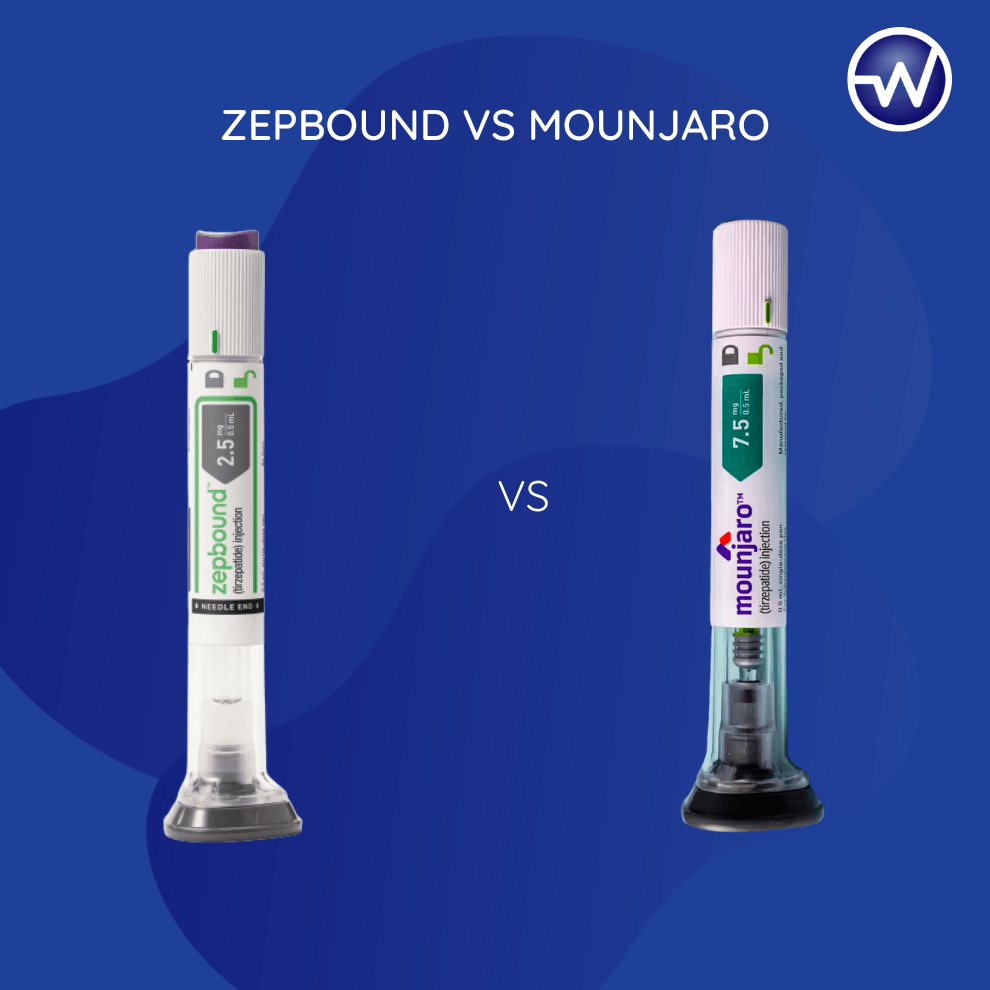Zepbound vs Mounjaro: Whats the difference?


Related products
The medical landscape is continually evolving, with the introduction of innovative drugs like Zepbound and Mounjaro offering new horizons in treatment modalities. This article goes into the specifics of these two drugs, comparing their effectiveness, dosages, and roles in therapeutic regimes.
The differences between Zepbound and Mounjaro primarily revolve around their FDA-approved indications and the conditions they are prescribed for. Both Zepbound and Mounjaro contain the same active ingredient, tirzepatide, but they are marketed under different brand names for different uses:
- Zepbound is approved for the treatment of overweight and obesity.
- Mounjaro is approved for the treatment of type 2 diabetes.
Despite these differences, the active ingredients and available dosages of Zepbound and Mounjaro are the same. They are both administered in several dosages, ranging from 2.5 mg to 15 mg. Zepbound's effectiveness was highlighted in the SURMOUNT-1 trial, where participants lost an average of 20% of their body weight on the highest dosage over 72 weeks, which may be more effective than other similar medications.
In terms of availability and cost, Zepbound is expected to be available in the U.S. by the end of 2023 at a list price of $1,059.87 for a month’s supply, slightly higher than Mounjaro's $1,023.04. Insurance coverage may significantly reduce these costs, and Eli Lilly has announced a potential 50% reduction in price for those without insurance coverage.
The key difference lies in their FDA-approved indications: Zepbound for weight management and Mounjaro for diabetes control, which can also result in weight loss. Please note that both Zepbound and Mounjaro are not available, however, Wegovy is.
What is Zepbound?
Zepbound (tirzepatide) is a medication approved for chronic weight management in adults who are either obese or overweight with weight-related medical conditions. It functions as a GIP and GLP-1 receptor agonist, reducing appetite and slowing gastric emptying, helping patients feel full longer. Administered as a once-weekly subcutaneous injection, it aims to aid in sustained weight loss when used alongside diet and exercise.
What is Mounjaro?
Mounjaro (tirzepatide) is an injectable prescription medicine used alongside diet and exercise to improve blood sugar control in adults with type 2 diabetes. As a dual GIP and GLP-1 receptor agonist, Mounjaro functions by enhancing the body's natural ability to lower blood sugar levels and also aids in weight loss. It is not recommended for treating type 1 diabetes or for use in people with a history of pancreatitis.

Is Zepbound or Mounjaro more effective?
Although Zepbound is a newly approved medication it is expected to be more effective in regards to weight loss, while Mounjaro is more effective for diabetes.
For weight loss specifically, Zepbound has shown substantial results in clinical trials, where patients lost an average of 16.1 kg to 23.6 kg over 72 weeks, depending on the dose. Mounjaro, while primarily approved for type 2 diabetes, also resulted in significant weight loss, with participants losing an average of 11.2 kg over 28 weeks in a clinical trial when administered the 15 mg dose.
Although both drugs contain the same active ingredient, tirzepatide, and have shown efficacy in weight loss, direct comparison is challenging since the trials had different durations and patient populations. Zepbound's trial emphasizes chronic weight management, whereas Mounjaro's data also highlights its impact on weight as a beneficial side effect alongside its primary goal of improving glycemic control in type 2 diabetes. Therefore, for weight loss as a primary endpoint, Zepbound has demonstrated a higher average weight loss in clinical trials.
Zepbound vs Mounjaro Dosages
The dosages of Zepbound and Mounjaro are similar, with both starting at a 2.5mg initial dose.The dosing regimens of these drugs are pivotal, not only for efficacy but also for patient compliance and safety. A consultant pharmacist, Dr. Emily Norton, posits, "The correct dosage can mean the difference between optimal therapeutic outcomes and a litany of unwanted side effects."
Zepbound Dosage
Following an initial four-week period, the dosage is to be augmented to 5 mg administered subcutaneously once per week. Subsequent dose escalations should be made in increments of 2.5 mg, and only after a minimum of four weeks on the current dosage to ensure patient adaptability and drug efficacy. The advised maintenance dose varies between 5 mg, 10 mg, or 15 mg, injected subcutaneously on a weekly basis, tailored to the patient's response and tolerance. The upper limit for dosing is set at 15 mg subcutaneously once a week.
Mounjaro Dosages
Mounjaro's dosing parameters are well-established. Beginning with a conservative dose of 2.5 mg once weekly, it is tailored upwards to a maximum of 15 mg based on patient tolerance and therapeutic needs. The incremental increase is a testament to the drug's potency and the necessity for a cautious approach to dosing—a sentiment echoed by Dr. Jacob Stewart, a renowned diabetologist, who states, "Mounjaro represents a significant advancement in our dosing arsenal against type 2 diabetes, necessitating a bespoke dosing strategy for each patient."
The confluence of these factors contributes to the perplexity and burstiness of dosing decisions, where each adjustment can have profound ramifications. As we delve deeper into the dosing comparison of Zepbound and Mounjaro, we are reminded of the delicate balance clinicians must strike in the art of prescribing, a balance that is continuously evolving with the advent of new treatments and ongoing research.
Zepbound vs Mounjaro Comparison Chart
| Feature | Zepbound | Mounjaro |
| Generic Name | Tirzepatide | Tirzepatide |
| Drug Type | GLP-1 and GIP receptor agonist | GLP-1 and GIP receptor agonist |
| Approved Uses | Weight-related condition; high blood pressure, heart disease or obstructive sleep apnea | Treats type 2 diabetes; may help with weight management |
| Mechanism of Action | Decreases appetite and slows the transport of food from stomach to small intestine, for fullness effect for longer | Mimics incretin hormones to stimulate insulin secretion |
| Effectiveness | At the highest dosage of 15 mg, individuals experienced an average weight loss of 48 pounds, whereas at the minimal dosage of 5 mg, the average weight loss was 34 pounds. | Shown to improve blood sugar levels and aid in weight loss |
| Dosage Form | Subcutaneous injection | Subcutaneous injection |
| Dosage | Start dose 2.5 mg, increased to 5 mg, 10 mg, then 15 mg | Starts at 2.5 mg once weekly, can be increased to 15 mg |
| Side Effects | nausea, diarrhea, vomiting, constipation, abdominal pain, hair loss, dyspepsia, injection-site reactions, fatigue, eructation, gastroesophageal reflux disease and hypersensitivity reactions. | Nausea, diarrhea, decreased appetite, potential thyroid tumors |
This chart provides a side-by-side comparison of Zepbound and Mounjaro, two drugs intended for medical treatment, outlining their primary attributes, such as generic names, drug types, approved uses, mechanisms of action, effectiveness, dosage forms, recommended dosages, potential side effects, cost, insurance coverage, and clinical trial outcomes.
Zepbound vs Mounjaro Side Effects
Zepbound and Mounjaro, due to their shared active ingredient, tirzepatide, are likely to have similar side effect profiles. Common side effects for Zepbound include abdominal pain, constipation, diarrhoea, nausea, and vomiting, among others. Serious side effects may include allergic reactions, pancreatitis, thyroid tumours, and more.
When examining the differences between Zepbound and Mounjaro, the side effect profile stands as a pivotal consideration for both clinicians and patients. Both medications, given their shared active ingredient, tirzepatide, present a similar landscape of side effects which must be navigated with care.
Dr. Jane Thompson, a leading endocrinologist, notes, "While Zepbound has shown promise in weight management, its side effects such as gastrointestinal disturbances and potential for serious conditions like pancreatitis cannot be overlooked. These are critical considerations when prescribing this medication." These side effects were reflected in the clinical trial data, where a significant proportion of participants reported symptoms like nausea and diarrhoea.
Mounjaro, primarily used to manage type 2 diabetes, shares a similar side effect profile to Zepbound due to the active ingredient, tirzepatide. According to Dr. Thompson, "Mounjaro's impact on glycemic control comes with the caveat of side effects that mirror those seen with Zepbound." However, the context of diabetes management introduces additional layers of complexity, as the medication's impact on blood sugar levels can interact with the side effects, potentially exacerbating or mitigating them.
Is Zepbound or Mounjaro more expensive?
Although the exact prices are not yet available, Zepbound is expected to be more expensive than Mounjaro. Mounjaro has a known cost range of approximately $975 to $1,200 for a four-week supply without insurance, while Zepbound is expected to cost about $1,060 per month.
"The cost of pharmaceuticals can be a barrier to treatment for many patients," notes healthcare economist Dr. Alan Grant. An analysis of market prices reveals that Wegovy, due to its established presence, commands a higher price point, whereas Zepbound, as a newcomer, is priced competitively. However, insurance coverage and pharmacy benefits can alter these dynamics drastically.
The price of Mounjaro and Zepbound may be justified by the potential to improve health risks, manage chronic conditions effectively, and reduce the overall burden of type 2 diabetes and weight-related conditions.
Conclusion
In the intricate dance of pharmaceutical innovation, Zepbound and Mounjaro have emerged as prominent figures. Throughout this article, we've unravelled the multifaceted layers of these medications, contrasting their mechanisms of action, efficacy, and the clinical nuances that define their use in the therapeutic landscape. Dr. Edward Langdon, a consultant endocrinologist, reiterates the sentiment that "In the realm of diabetes management, the introduction of Zepbound and Mounjaro has been a paradigm shift, offering patients bespoke treatment options."
Statistical analyses underscore the differential impact of these drugs, with Zepbound's weight loss statistics at various dosages painting a compelling picture of its potential. Meanwhile, Mounjaro, with its dual action on incretin receptors, presents a formidable profile of blood glucose management, as corroborated by the data from several Phase III clinical trials.
The financial facet of these treatments cannot be overlooked. The cost considerations, as we've seen, play a crucial role in patient accessibility and adherence, with Zepbound and Mounjaro each positioning themselves differently within the market. "The economic implications of new drug therapies are as significant as their clinical benefits," states healthcare economist Dr. Fiona Harrington.
In essence, Zepbound and Mounjaro are not just mere substances; they are beacons of hope for countless individuals, embodying the relentless pursuit of better health. With each stride forward, we are reminded of the tenacity of human ingenuity and the profound impact of medical science on society.







 Rated Excellent by 26,523+ Reviews
Rated Excellent by 26,523+ Reviews